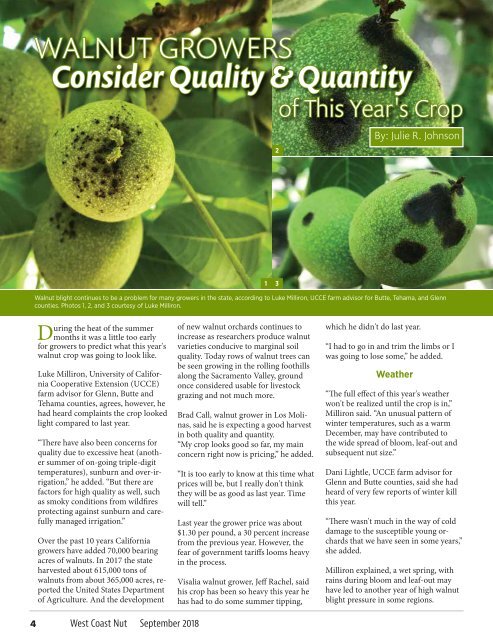test test test
test test test
test test test
Create successful ePaper yourself
Turn your PDF publications into a flip-book with our unique Google optimized e-Paper software.
WALNUT GROWERS<br />
Consider Quality & Quantity<br />
of This Year's Crop<br />
2<br />
By: Julie R. Johnson<br />
1<br />
3<br />
Walnut blight continues to be a problem for many growers in the state, according to Luke Milliron, UCCE farm advisor for Butte, Tehama, and Glenn<br />
counties. Photos 1, 2, and 3 courtesy of Luke Milliron.<br />
During the heat of the summer<br />
months it was a little too early<br />
for growers to predict what this year's<br />
walnut crop was going to look like.<br />
Luke Milliron, University of California<br />
Cooperative Extension (UCCE)<br />
farm advisor for Glenn, Butte and<br />
Tehama counties, agrees, however, he<br />
had heard complaints the crop looked<br />
light compared to last year.<br />
“There have also been concerns for<br />
quality due to excessive heat (another<br />
summer of on-going triple-digit<br />
temperatures), sunburn and over-irrigation,”<br />
he added. “But there are<br />
factors for high quality as well, such<br />
as smoky conditions from wildfires<br />
protecting against sunburn and carefully<br />
managed irrigation.”<br />
Over the past 10 years California<br />
growers have added 70,000 bearing<br />
acres of walnuts. In 2017 the state<br />
harvested about 615,000 tons of<br />
walnuts from about 365,000 acres, reported<br />
the United States Department<br />
of Agriculture. And the development<br />
of new walnut orchards continues to<br />
increase as researchers produce walnut<br />
varieties conducive to marginal soil<br />
quality. Today rows of walnut trees can<br />
be seen growing in the rolling foothills<br />
along the Sacramento Valley, ground<br />
once considered usable for livestock<br />
grazing and not much more.<br />
Brad Call, walnut grower in Los Molinas,<br />
said he is expecting a good harvest<br />
in both quality and quantity.<br />
“My crop looks good so far, my main<br />
concern right now is pricing,” he added.<br />
“It is too early to know at this time what<br />
prices will be, but I really don't think<br />
they will be as good as last year. Time<br />
will tell.”<br />
Last year the grower price was about<br />
$1.30 per pound, a 30 percent increase<br />
from the previous year. However, the<br />
fear of government tariffs looms heavy<br />
in the process.<br />
Visalia walnut grower, Jeff Rachel, said<br />
his crop has been so heavy this year he<br />
has had to do some summer tipping,<br />
which he didn't do last year.<br />
“I had to go in and trim the limbs or I<br />
was going to lose some,” he added.<br />
Weather<br />
“The full effect of this year's weather<br />
won't be realized until the crop is in,”<br />
Milliron said. “An unusual pattern of<br />
winter temperatures, such as a warm<br />
December, may have contributed to<br />
the wide spread of bloom, leaf-out and<br />
subsequent nut size.”<br />
Dani Lightle, UCCE farm advisor for<br />
Glenn and Butte counties, said she had<br />
heard of very few reports of winter kill<br />
this year.<br />
“There wasn't much in the way of cold<br />
damage to the susceptible young orchards<br />
that we have seen in some years,”<br />
she added.<br />
Milliron explained, a wet spring, with<br />
rains during bloom and leaf-out may<br />
have led to another year of high walnut<br />
blight pressure in some regions.<br />
4<br />
West Coast Nut September 2018


















